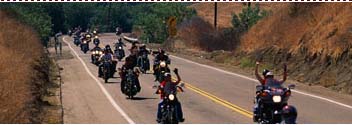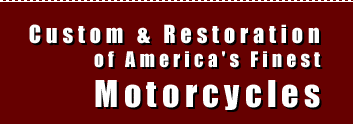 |

  
Indian Motorcycle - May 1995
Wymond Walkem’s Service For Serious Riders
Story by Bob Tedeschi
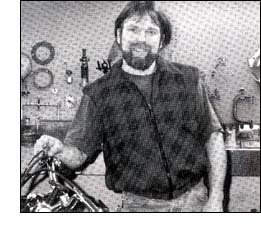 In
the summer of 1971, Wymond Walkem was a 16-year-old kid, hanging
out in the suburbs of Toronto, and riding his Harley along side
a buddy who owned an old Chief. "I was the more mechanically
inclined of the two of us, so I ended up doing all the work,"
Walkem recalls. In
the summer of 1971, Wymond Walkem was a 16-year-old kid, hanging
out in the suburbs of Toronto, and riding his Harley along side
a buddy who owned an old Chief. "I was the more mechanically
inclined of the two of us, so I ended up doing all the work,"
Walkem recalls.
Since these were the days of Janis Joplin, Jimi Hendrix, hip-huggers,
and (most notably) choppers, Walkem took a hacksaw to both his and
his buddy’s bikes, and, of course, raked the front end to
radical angles. And, as both motorcycles were vintage bikes with
more than their share of maintenance quirks, Walkem got to know
the inner workings of both choppers quite well. Nearly 25 years
later, Walkem has transformed the experience he gained from those
bikes into a thriving motorcycle restoration and repair business,
serving owners of vintage American bikes in his homeland (Canada),
the U.S., and abroad.
Walkem still does choppers — even Indian chopper — but
the watchword for his restorations isn’t just style. Rather,
it’s style and quality. And, if the number of Walkem's customers
is any indication, it’s a combination that is serving a substantial
market.
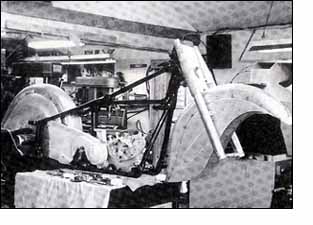 "We're
just knockin’ everybody dead," Walkem said of his business'
growth. "Our business has been growing ever since we opened
our doors." Of course, Walkem didn't jump into business as
a greasy-handed teenager. He paid his dues. "My first real
move into this business was going to Harley mechanic school in the
1970s," he recalls. "After that, I became a shop foreman,
and I learned more about the business end of things. Then I opened
up this shop in 1979." "We're
just knockin’ everybody dead," Walkem said of his business'
growth. "Our business has been growing ever since we opened
our doors." Of course, Walkem didn't jump into business as
a greasy-handed teenager. He paid his dues. "My first real
move into this business was going to Harley mechanic school in the
1970s," he recalls. "After that, I became a shop foreman,
and I learned more about the business end of things. Then I opened
up this shop in 1979."
Now, as then, Walkem divides his time between Harleys and Indians.
But make no mistake about which bike he favors. "The Harleys
are an easy way for me to pay the bills," he said. "But
with the Indians, what can I say? It's a labor of love, it's just
a bonus."
And this labor of love is more than a sidelight to his business.
Walkem's shop is full of Indians and Indian parts in various stages
of repair and restoration, and he completes about three Indian basketcase-to-roadworthy
restorations each year. The business runs with a maximum of six
full-time workers in the peak months of summer.
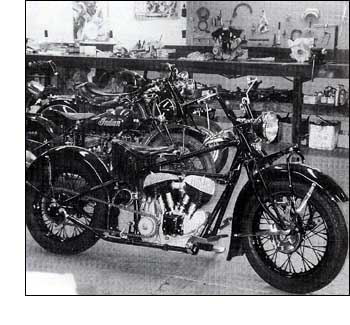 Walkem's
specialty, he says, is everything. "We’ve got a full
machine shop, we do milling, lathing, forging, sand-blasting, welding,
blue-printing — everything. The only thing we don't do is the
actually chroming and cad plating. But we do all the prep work for
that, even. We do the buffing — everything — so we know
it can't be screwed up." Walkem's
specialty, he says, is everything. "We’ve got a full
machine shop, we do milling, lathing, forging, sand-blasting, welding,
blue-printing — everything. The only thing we don't do is the
actually chroming and cad plating. But we do all the prep work for
that, even. We do the buffing — everything — so we know
it can't be screwed up."
I he had to boil down his business philosophy into one thought,
it would be this: "We build some serious pure Indians, but
we're interested in building road-able motorcycles more than anything,"
he says.
For instance, let's say a customer walks through Walkem's doors
with a 1946 Chief, looking for a 100-point restoration. Walkem will
do the job, but not without delivering a few words of wisdom. "I'd
try to convince him to make it as road-able as possible. So first
thing, I'd tell him to ditch the six volt system, and go to 12 volts."
Along those lines, one of Walkem's most frequent modifications
is a conversion from an Indian generator to a modern Harley generator.
"And we modify the generator housing so you have no idea it's
a different generator — it just works a hundred percent better.
Some people are throwing these VW parts into their Indians. Why
bother?"
Regardless of how you upgrade your electrics, Walkem said the important
thing is that they are modernized. "If you don't, you've got
headlights you can't see anything with, and a taillight that no
one can see you with. And one day you get rear-ended. Hey, you're
busted up, the bikes busted up. And whose fault is it? It just doesn't
make much sense to get hurt just because you're a purist."
 On
the subject pf pain, Walkem is aware that it might hurt the eyes
of Indian enthusiasts to see chopped-up Chiefs rolling out of his
shop. Don't reach for the hankie quite yet, he warns. "We're
not afraid of chopping something, but we'll only do it on a bent
frame, if we find one," he said. "We don't chop any cherry
stuff. We're not stupid." On
the subject pf pain, Walkem is aware that it might hurt the eyes
of Indian enthusiasts to see chopped-up Chiefs rolling out of his
shop. Don't reach for the hankie quite yet, he warns. "We're
not afraid of chopping something, but we'll only do it on a bent
frame, if we find one," he said. "We don't chop any cherry
stuff. We're not stupid."
"And don't get me wrong. We'll do a pure restoration if a
customer wants it, no question about it," he says, laughing.
"Just don't ride with us if you can't keep up."
Most of Walkem's restorations are Chiefs of the 1940s and '50s,
although he'll also tackle the earlier models, if asked. Again,
he prefers the "newer" Chiefs because they're ones most
likely to be ridden — and ridden in a way that does honor to
the Indian marque. That is, he wants them to hit the road often,
and perform as good as (or better than) any other bike on the road.
"All the guys who work here really ride their old bikes,"
he said. "I've got a '53 Chief that I ride everywhere. Every
year, we pack up our saddlebags and head to Springfield (for "Indian
Days"). Of course we hit Cape Cod, first."
While there, and at Sturgis (he rides there, too) and other events,
Walkem runs into owners of Indians that he has restored. Walkem
said a vast majority of his customers are Canadian, but Americans
and Europeans, Australians and New Zealanders also populate his
customer list in increasing numbers. Often, these customers have
tried restorations themselves, first.
"Of course, it ends up costing them more than if they had
brought it to us in the first place, because we have to rework everything
they did wrong. Why they do it, who knows? Maybe they figure it'll
get 'em some time away from the wife and kids…"
|
 |
